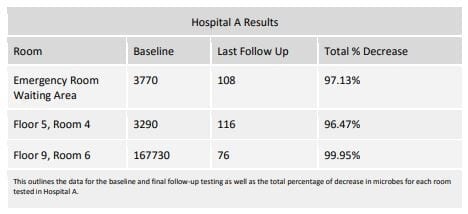
Right now, facility managers and building owners have been working hard to make sure they keep their buildings safe and clean for both their employees and visitors, especially in healthcare facilities. Many hospitals, as well as nursing homes have patients who are older and/or may have a weakened immune system. As a fire and life safety company we are always looking for ways to provide our customers with services and products to help them keep their employees, patients, as well as visitors safe and healthy during this time. A new product LSS is now offering is BioProtect solutions to help fight against viruses and bacteria. BioProtect is a patented, water-based, antimicrobial technology that provides continuous protection on surfaces for up to 60-90 days. So how exactly does BioProtect work?
BioProtect is a 3-step process, and when applied to a porous or non-porous surface, or incorporated into a material, forms a covalent bond with the substrate, creating a micro-biostatic antimicrobial coating. This coating forms a layer of self-assembling monolayer, each of which carry a positive charge that attracts negatively charged bacteria. Once attracted, the molecular spikes pierce the cell and rupture its cellular membrane. This technology inactivates dangerous microorganisms and bacteria and inhibits the growth of mold, mildew, fungi and algae.
In fact, according to this study, BioProtects’s efficacy was tested over a 3 month period at 3 different hospitals across the United States. Testing was performed by Microbac Laboratories, Inc., for Hospitals A & B and Chestnut Laboratories conducted the testing for Hospital C. Within each hospital, 2 to 3 high traffic areas were selected for testing including a variety of different substrates. Swab tests were performed every 15 days over a 3 month period in 2010. The tests were monitored by each hospital’s environmental supervisor and sent to the third party labs for testing.
Hospital A: University of Louisville Hospital
The hospital’s emergency room is one of the largest trauma facilities in the country and is able to accommodate up to 86 patients simultaneously. The center is staffed 24-hours a day and admits more than 2,400 patients each year; 40 percent of those are referred from other hospitals throughout the region. No patient numbers were readily available for the inpatient facilities.
Results: Reports from Microbac Laboratories, a significant decrease in microbes in all areas treated and tested was found. In fact, the average decrease in harmful bacteria and microbes for the three rooms treated and tested was 97.85%.

Hospital B: Nationwide Children’s Hospital
As one of the largest and most comprehensive pediatric hospitals and research institutes in the United States, this hospital is home to the department of pediatrics for a local university medical school. In a typical year, the hospital sees patients from across the country and around the world. Maintains a medical staff of approximately 950, a hospital staff of 6,800, and delivers pediatric care for almost 823,000 patient visits annually.
Results: Reports from Microbac Laboratories, a significant decrease in microbes in all areas treated and tested was found. The average decrease in harmful bacteria and microbes for the two rooms treated and tested was 68.44 %. This result is lower than generally found in Hospitals A and C. The difference is explained by the notes on the Microbac Laboratories results certificate. Microbac determined the baseline data presented by the previous laboratory was invalid due to poor quality standards. Therefore, calculations for % of decrease were completed using the data from the first follow-up rather than the baseline.

Hospital C: Freeman Hospital
A teaching hospital and features a 404-bed, three-hospital system, which includes a comprehensive behavioral health center. The facility has recently completed a $47 million expansion project and is a member of the Oklahoma Osteopathic Medical Consortium of Oklahoma and the regional Osteopathic Postdoctoral Training Institution and an affiliate of Oklahoma State University-College of Medicine.
Results: Reports from Chestnut Labs, a significant decrease in microbes in all areas treated and tested was found. In fact, the average decrease in harmful bacteria and microbes for the two rooms treated and tested at Hospital C was an astounding 99.84 %!


